Spider-Man: Across the Spider-Verse
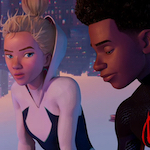 SPIDER-MAN: ACROSS THE SPIDER-VERSE is the first sequel to SPIDER-MAN: INTO THE SPIDER-VERSE, the brilliant 2018 movie I still believe is a watershed moment for computer animated features* as well as super hero cinema. I’m happy to say that ACROSS is a worthy sequel that finds a smart way to build on the first film’s clever multiverse premise and push its revolutionary visual style into the stratosphere. Miles gives me the same “it’s weird to see him taller” feeling as real kids I’ve seen grow up, and the series’ already astonishing artistry has also experienced a growth spurt. Honestly the gimmicks and the eye candy would be enough to make this a classic, but they’re not the only reason these movies have become a phenomenon. They’ve also given us characters to really care about as they live their lives in that perfect Spider-Man intersection between regular every day problems and universe-shattering super shit.
SPIDER-MAN: ACROSS THE SPIDER-VERSE is the first sequel to SPIDER-MAN: INTO THE SPIDER-VERSE, the brilliant 2018 movie I still believe is a watershed moment for computer animated features* as well as super hero cinema. I’m happy to say that ACROSS is a worthy sequel that finds a smart way to build on the first film’s clever multiverse premise and push its revolutionary visual style into the stratosphere. Miles gives me the same “it’s weird to see him taller” feeling as real kids I’ve seen grow up, and the series’ already astonishing artistry has also experienced a growth spurt. Honestly the gimmicks and the eye candy would be enough to make this a classic, but they’re not the only reason these movies have become a phenomenon. They’ve also given us characters to really care about as they live their lives in that perfect Spider-Man intersection between regular every day problems and universe-shattering super shit.
This one works particularly well on the level of a teen movie. You may remember that our main characters Miles Morales/Spider-Man (Shameik Moore, Raekwon on Wu-Tang: An American Saga), and Gwen Stacy/Spider-Woman (Hailee Steinfeld, 3 DAYS TO KILL) exist in different realities. As in, different dimensions, timelines, worlds, whatever. They met when a super-collider brought Gwen and people from various other realities into Miles’s, but now they’re apart, trying to get through life as their reality’s Spider-Person.
Each have normal issues with their parents, exacerbated by their secret super hero lives. Gwen’s have to do with her dad (Shea Whigham, SICARIO: DAY OF THE SOLDADO) being the police captain chasing Spider-Woman, blaming her for the death of their universe’s Peter Parker (Jack Quaid, LOGAN LUCKY), a misunderstanding they can’t clear up because she hides her true self from him. When her secret comes out under duress it goes so poorly that she takes an opportunity to abandon their reality.
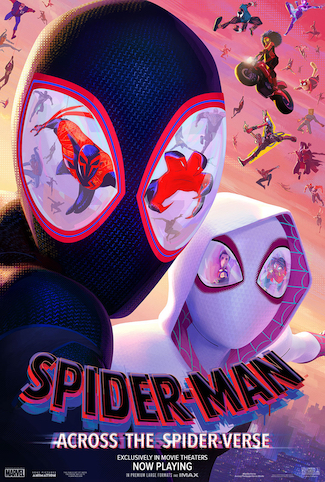 That’s one reason there’s tension about whether Miles should risk coming out as Spider-Man to his parents, Jeff (Brian Tyree Henry, CHILD’S PLAY remake) and Rio (Luna Lauren Velez, THE FIRST PURGE). They do understand that he’s brilliant, and that his grades are great by anyone else’s standards. Even in his crime-fighting life, taking on a fake deep voice when talking to his cop dad on the job, the relationship seems to be improving a little bit. They just worry he’s a fuck up because he keeps showing up late to everything and giving flimsy excuses for it, things that could be cleared up by telling them the truth. But even for a guy who jumps off buildings all day that’s a scary leap to take.
That’s one reason there’s tension about whether Miles should risk coming out as Spider-Man to his parents, Jeff (Brian Tyree Henry, CHILD’S PLAY remake) and Rio (Luna Lauren Velez, THE FIRST PURGE). They do understand that he’s brilliant, and that his grades are great by anyone else’s standards. Even in his crime-fighting life, taking on a fake deep voice when talking to his cop dad on the job, the relationship seems to be improving a little bit. They just worry he’s a fuck up because he keeps showing up late to everything and giving flimsy excuses for it, things that could be cleared up by telling them the truth. But even for a guy who jumps off buildings all day that’s a scary leap to take.
One thing I think ACROSS gets really gets right is the teen longing. Miles and Gwen miss each other so much. Miles is really doing well in his web-slinging life but he keeps thinking about the girl who helped him get there, the person who understands what he’s going through most. He draws pictures of her in his notebook – not just her face, but also her mask. So he doesn’t just think she’s purty, he thinks she looks cool in her super hero persona. He admires her work.
It’s like she’s the cool girl who goes to a different school or who he met on a vacation, except being in a different reality is a little more extreme. And the filmatists do such a good job of making her the ultimate cool girl to have a crush on: she’s funny, she’s great at what she does, she has a badass haircut and cool fashion, she plays drums, she’s an outsider, she’s very assertive, she leaves her sweater in his bedroom. It really gets that teenage exhilaration of Miles dreaming about this girl and then all the sudden she’s there. She climbs through his window and they put on their costumes and go swinging across the city together, excited to catch up and show off what they’ve learned. Later there’s a great scene where they have a good talk while casually hanging from a clock tower. It looks like a normal looking-out-over-the-horizon shot except the skyline is inverted and Gwen’s ponytail is hanging straight up.
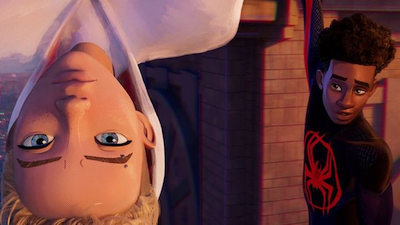 Most of Gwen’s news is about the inter-dimensional elite spider-team she ran away with, the Spider-Society, and all her cool new friends she wishes Miles could meet. She’s cagey about why, with a wrist device that allows her to travel between realities, she didn’t come see him right away, but there’s obviously some Prime Directive type reason why she wasn’t supposed to see him at all. Her job is to go around finding people in the wrong realities and correct things before everything else gets out of wack – an ongoing multiversal problem stemming from the events of part 1.
Most of Gwen’s news is about the inter-dimensional elite spider-team she ran away with, the Spider-Society, and all her cool new friends she wishes Miles could meet. She’s cagey about why, with a wrist device that allows her to travel between realities, she didn’t come see him right away, but there’s obviously some Prime Directive type reason why she wasn’t supposed to see him at all. Her job is to go around finding people in the wrong realities and correct things before everything else gets out of wack – an ongoing multiversal problem stemming from the events of part 1.
Miles learns about this only from sneaking through Gwen’s portal and being allowed a day pass into a headquarters populated by even more spider-beings than we saw in the first movie. There are some more meta/in-jokes, like cameos from the crudely animated Spider-Men of previous TV and video game incarnations, and a few live action references, which I’m glad they don’t spend much time on since that feels like a worn out gimmick after NO WAY HOME. (In retrospect though it makes me laugh that I saw a clickbait headline something like “Behind those INSANE Spider-Verse cameos” and now I know that means one major actor plus outtakes of the bodega owner [Peggy Lu] from the VENOM movies. In Association With Marvel Cinematic Universe represent.)
With the exception of Miles’ mentor Peter B. Parker (Jake Johnson, REDBELT), most of the supporting-spider-people from part INTO are only seen briefly, leaving room to introduce newbies like Spider-Woman Jessica Drew (Issa Rae, THE LOVEBIRDS) (who Gwen can’t help but idolize) and the Spider-Man of “Mumbattan,” Pavitr Prabhakar (Karan Soni, SUPREMACY) (who brags that he doesn’t use any product in his hair). But Peter Porker Spider-Ham, Spider-Man Noir, etc. seem set to return next time, like when the casts were united in STEP UP 3 or FAST & FURIOUS.
The screenplay this time is credited to LEGO® MOVIE/21 JUMP STREET dudes Phil Lord & Chris Miller, plus, to my surprise, Dave Callaham (DOOM, THE EXPENDABLES, Jean-Claude Van Johnson, MORTAL KOMBAT). There’s a new trio of directors: Joaquim Dos Santos (G.I. Joe: Resolute), Kemp Powers (SOUL, writer of ONE NIGHT IN MIAMI…), and Justin K. Thompson (production designer of the first one). It’s exciting that between the two SPIDER-VERSE movies there are six really talented directors learning new things that they’ll probly build off of in other movies, including next year’s (we hope) BEYOND THE SPIDER-VERSE.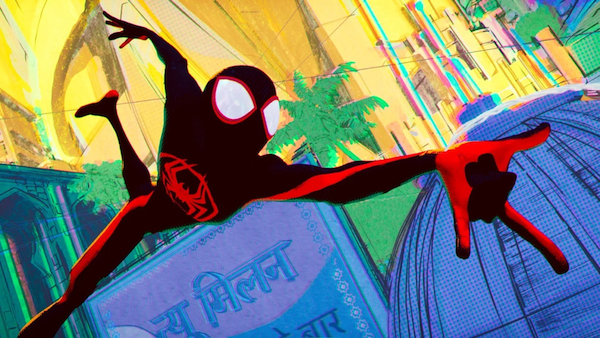
The first SPIDER-VERSE worked brilliantly on a meta level about storytelling because it told us there are infinite variations; you don’t have to be mad if Miles isn’t your Spider-Man or even if he isn’t your Miles, because he’s just one version in the multiverse. This one looks at it from a slightly different angle. According to Spider-Society leader Miguel O’Hara, a.k.a. Spider-Man 2099 (Oscar Isaac, X-MEN: APOCALYPSE), there are still rules – commonalities between universes he calls “canon events.” For example, he believes there has to be some version of Peter Parker’s uncle Ben, or Miles’ uncle Aaron, dying, in order for him to become a hero. So the philosophical debate between super heroes here is about whether or not it’s necessary to allow certain bad things to happen for the greater good. But on another level Miles is fighting for his true uniqueness. It’s beautiful that all the Spider-Versions are at their core the same, while representing so many different cultures and backgrounds. But Miles is not only the Afro-Latino, graffiti artist, kinda nerdy, Brooklyn Spider-Man. He’s also just Miles. And he refuses to let anyone else decide what that means, what he has to do, what his reality and destiny have to be.
Implausible as it may be, I love that Miguel chooses to call these expectations “canon,” because it has set up a comic book movie where the big world ending event our heroes have to stop is the necessity of following canon. Take that, talkbackers.
That brings up the first of my two complaints about ACROSS THE SPIDER-VERSE, which is that it’s part one of two. (Like FIST OF THE CONDOR, its first trailer had “PART ONE” in the title, but luckily I remembered that this time.) A comparison can be made to THE EMPIRE STRIKES BACK, but I was a little kid when that came out, I can’t remember if it felt as satisfying before RETURN OF THE JEDI existed. Here is an absorbing and visually stunning movie that, for now, is an incomplete story. In that sense it’s not as good as the first one.
My second complaint is that every time they said the name of the company “Alchemax” I thought for a second they said “Malcolm X.” But both of these issues will fade away with time, I’m sure.
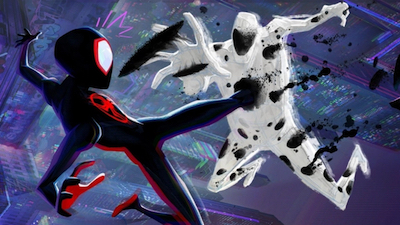 But focusing on any minor complaints would be silly in the face of all the things ACROSS THE SPIDER-VERSE knocks out of the park, especially considering how much they’ve leveled up on the aspect of INTO THE SPIDER-VERSE that’s most essential to its chosen medium – the way it exploded the style of modern computer animation. As visually revolutionary as the first one was with its varied frame rates, Zip-a-Tone dots and hand drawn linework over three-dimensional models, it seems almost timid compared to this one. Every reality has a different design style, allowing for far more hand drawn animation and stylistic experimentation. They still have the thought bubbles, motion lines and editor’s notes inspired by the newsprint/screen printing era of comics, and they push even further into the ’90s-through-present-day glossy-print era where so many different illustration styles and medias have been explored.
But focusing on any minor complaints would be silly in the face of all the things ACROSS THE SPIDER-VERSE knocks out of the park, especially considering how much they’ve leveled up on the aspect of INTO THE SPIDER-VERSE that’s most essential to its chosen medium – the way it exploded the style of modern computer animation. As visually revolutionary as the first one was with its varied frame rates, Zip-a-Tone dots and hand drawn linework over three-dimensional models, it seems almost timid compared to this one. Every reality has a different design style, allowing for far more hand drawn animation and stylistic experimentation. They still have the thought bubbles, motion lines and editor’s notes inspired by the newsprint/screen printing era of comics, and they push even further into the ’90s-through-present-day glossy-print era where so many different illustration styles and medias have been explored.
Gwen battles a DaVinci-sketch-inspired Vulture made of crinkled parchment. Her world has impressionistic watercolor backgrounds; in one of the most emotional scenes the swaths of color that form her bedroom begin to drip. The main villain, The Spot (Jason Schwartzman, SLACKERS), has visible construction lines (the light pencil circles and lines artists sometimes use to rough out the shape of a body). The standout new cast member Hobie, a.k.a. Spider-Punk (Daniel Kaluuya, SICARIO), is designed as a collage of xeroxes, complete with cut-out outlines.
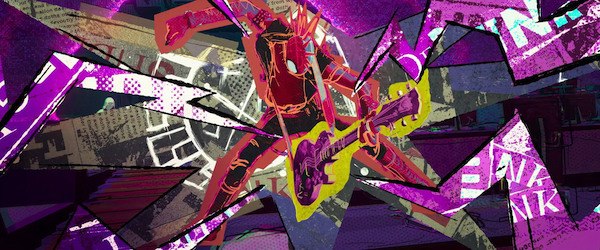
They obviously poured so much thought and love into making this look amazing. For example I read that Spider-Punk’s body parts are animated at different frame rates, and that artist Rick Leonardi worked with them to create 3D tools to mimic his linework on the Spider-Man 2099 comic book. Miguel’s holographic assistant Lyla (Greta Lee, GEMINI) is probly part of that, but she made me think of the chaotic painted style of Bill Sinkevitch. All this comes together in a wild mix of disciplines and mediums, a hybrid of techniques so well executed I can’t always tell whether I’m looking at drawings or computer creations inspired by them. Usually it’s obvious.
So much great animation has been created with computers over the last three decades, but the limits of the technology and the unwritten rules created by past successes have caused the format to be dominated by a very neat and clean style. It’s a thrill to see computer animation slathered in so much stylish mess – paint splatters, smudges, lines, brush strokes, figurative (and I’m sure at some point literal) fingerprints of the many artists who work on these things at all levels.
The more our popular art gets devoured by tech ghouls and unsustainable stock market scams, the more it becomes clear to me that the creation of art – a song, or a drawing, or a series of words that a unique individual transmits from inside themselves – is a sacred act. And fortunately there will always be artists creating on their own. It doesn’t need to be expensive, gigantic, meant for the masses. It certainly doesn’t have to be about Spider-Man and what not! But shit, I’m a movie critic, a movie lover, a summer movie-goer, obviously I enjoy seeing artists create on a massive scale. I like comic book movies and shit, so I love to see this done with such excellence, such imagination, such an unbridled creative spirit. Not sanded down, not taking short cuts, deeply considered, but not second guessed. From interviews and social media posts and what not I get the sense that individual animators, designers, and everyone involved in ACROSS THE SPIDER-VERSE are particularly excited and proud of it, and they should be. It warms my heart to imagine how many kids are running out of the theater not just wanting to be Miles or Gwen or Spider-Punk or Pavitr, but to figure out how to draw them.
*In my review of INTO THE SPIDER-VERSE I wrote that I felt “confident it will encourage more stylistic boldness in the animation studios.” Five years later I think this has borne out. Miller & Lord produced THE MITCHELLS VS. THE MACHINES for Netflix, which had lots of frenetic, doodle-inspired touches over its three-dimensional animation, and pushed the cartoony character animation and other techniques they reportedly carried into the SPIDER-VERSE sequel.
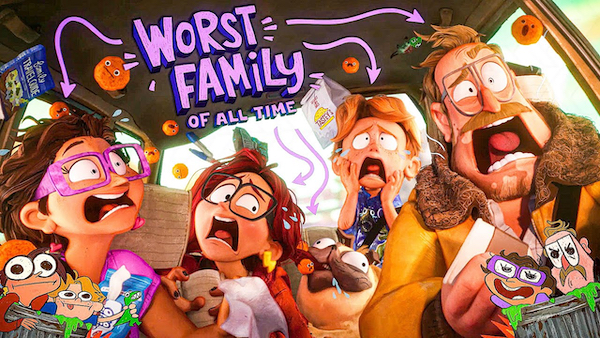
PUSS IN BOOTS: THE LAST WISH surprisingly changed styles from its predecessor, to create a more painterly, smudgy look, as well as experimenting with different frame rates when a herky-jerky look is preferred.
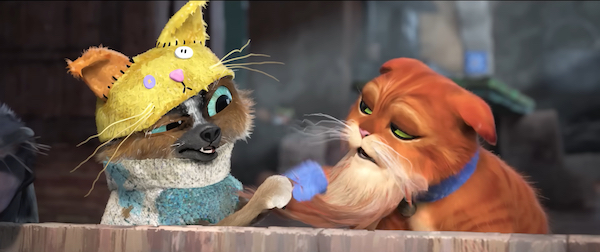
I’m genuinely excited for the upcoming TEENAGE MUTANT NINJA TURTLES: MUTANT MAYHEM, partly because the trailer actually made me laugh, and moreso because the visual style just blows me away. I still can’t believe this is a screengrab I made from an animated shot in the trailer – doesn’t it look like the oil pastel concept art you see in an “art of” book and think “I wish the movie could look as good as the concept art”?
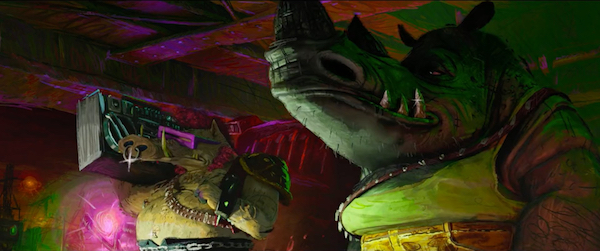
Even conservative Disney seems to have been influenced, as their upcoming movie WISH adopts a painterly look to its backgrounds and subtle use of outlining on its 3D models to make them look more like storybook illustrations.
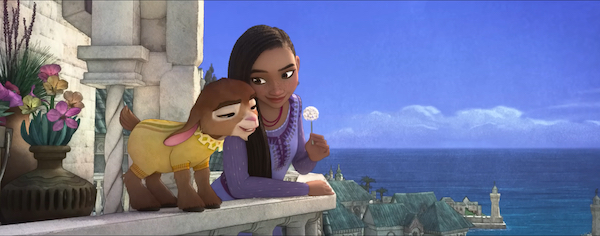
Honestly I don’t love that look, but Irespect that they’re taking visual risks even in princess movies. Could be good for the art form in the long run. And I’m sure there are other movies I could mention, like THE BAD GUYS and some of the smaller Netflix movies.
Of course, it’s now time to move beyond “how can we make CG look more graphic” into other experiments, but this is a start!
The post Spider-Man: Across the Spider-Verse first appeared on VERN'S REVIEWS on the FILMS of CINEMA.
